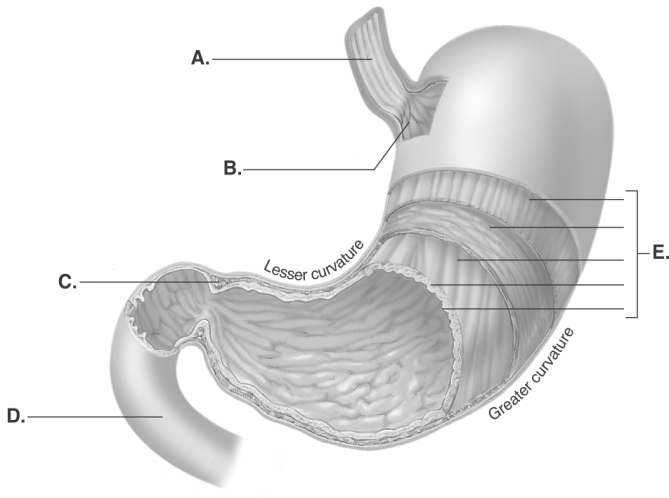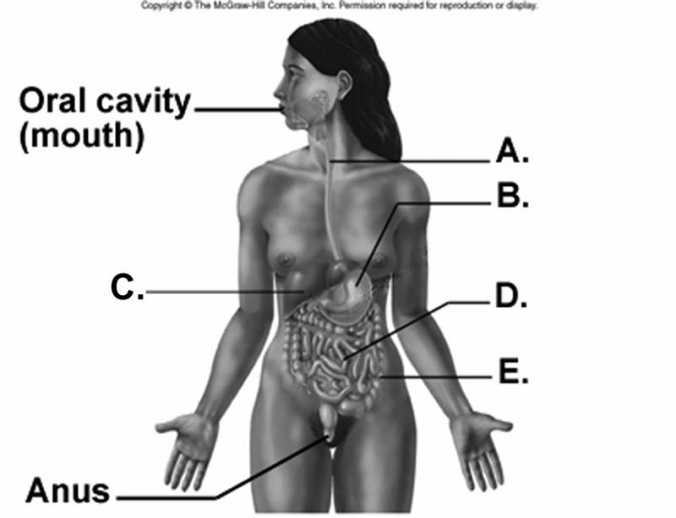A) acidic chyme in duodenum
B) secretin
C) gastrin
D) cholecystokinin
E) pepsin
Correct Answer

verified
Correct Answer
verified
Multiple Choice
What moves the bolus during the esophageal phase of deglutition?
A) pharyngeal constriction
B) peristalsis
C) the tongue
D) segmentation
Correct Answer

verified
Correct Answer
verified
Multiple Choice
Which of the following is NOT a function of the small intestine?
A) mastication of food
B) absorption of nutrients
C) complete digestion of food
D) mixing by segmental contractions
Correct Answer

verified
Correct Answer
verified
Multiple Choice
What is the purpose of segmental contractions of the small intestine?
A) propelling the chyme forward
B) mixing of intestinal contents
C) moving intestinal contents into the colon
D) stretching the intestinal wall
Correct Answer

verified
Correct Answer
verified
Multiple Choice
Mastication
A) increases the surface area of food particles.
B) decreases the efficiency of digestion.
C) occurs in both the mouth and stomach.
D) is never under voluntary control.
E) decreases the surface area of food particles.
Correct Answer

verified
Correct Answer
verified
Multiple Choice
Emulsification
A) converts small lipid droplets into larger droplets.
B) occurs in the gallbladder.
C) chemically digests lipids.
D) increases surface area for lipid digestion.
E) involves enzymes.
Correct Answer

verified
Correct Answer
verified
Multiple Choice
Match the process or term with the best description. -Kupffer cells
A) swallowing
B) chewing
C) ball of food
D) semifluid material
E) phagocytosis
Correct Answer

verified
Correct Answer
verified
Multiple Choice
How much saliva is generally produced each day?
A) ½ - 1 L
B) 1 - 1½ L
C) 2 - 3 L
D) 4 - 5 L
Correct Answer

verified
Correct Answer
verified
Multiple Choice
Which is the correct order of the regions of the digestive tract from superior to inferior?
A) pharynx, esophagus, large intestine, small intestine
B) oral cavity, stomach, small intestine, large intestine
C) stomach, esophagus, large intestine, small intestine
D) anus, large intestine, stomach, esophagus
Correct Answer

verified
Correct Answer
verified
Multiple Choice
Match the cell type with its function. -endocrine cells
A) produce hormones
B) produce mucus
C) may protect intestinal epithelium
D) synthesize bile
E) produce digestive enzymes
Correct Answer

verified
Correct Answer
verified
Multiple Choice
Which of the following attaches the liver to the anterior abdominal wall?
A) greater omentum
B) lesser omentum
C) transverse mesocolon
D) falciform ligament
E) round ligament
Correct Answer

verified
Correct Answer
verified
Multiple Choice
 -The diagram illustrates the anatomy of the stomach. What does "A" represent?
-The diagram illustrates the anatomy of the stomach. What does "A" represent?
A) muscularis
B) duodenum
C) esophagus
D) pyloric sphincter
E) cardiac part
Correct Answer

verified
Correct Answer
verified
Multiple Choice
The pancreatic islets
A) are found in the wall of the stomach.
B) excrete mucus.
C) produce digestive enzymes.
D) are exocrine glands.
E) are endocrine glands.
Correct Answer

verified
Correct Answer
verified
Multiple Choice
 -What does "B" represent on the diagram?
-What does "B" represent on the diagram?
A) small intestine
B) large intestine
C) esophagus
D) stomach
E) liver
Correct Answer

verified
Correct Answer
verified
Multiple Choice
Which of the following is an end product of protein digestion?
A) glucose
B) amino acids
C) LDL molecules
D) micelles
E) nucleic acids
Correct Answer

verified
Correct Answer
verified
Multiple Choice
Which of the following is an accessory organ of the digestive tract?
A) pharynx
B) stomach
C) liver
D) large intestine
Correct Answer

verified
Correct Answer
verified
Multiple Choice
The muscularis layer in the wall of the digestive tract is
A) skeletal muscle throughout the tract, especially in the large intestine.
B) the layer of the digestive tract wall that contains capillaries.
C) in direct contact with the food that is consumed.
D) composed of a layer of circular smooth muscle fibers and a layer of longitudinal smooth muscle fibers.
E) connective tissue and the peritoneum.
Correct Answer

verified
Correct Answer
verified
Multiple Choice
Which of the following organs is part of the digestive tract or alimentary canal?
A) salivary gland
B) liver
C) gallbladder
D) stomach
E) pancreas
Correct Answer

verified
Correct Answer
verified
Multiple Choice
Match the organ with the function. -duodenum
A) produces bile
B) stores and concentrates bile
C) primary site of chemical digestion
D) produces intrinsic factor
E) bacterial decomposition
Correct Answer

verified
Correct Answer
verified
Multiple Choice
Assume we could alter the conditions in the duodenum. If we inserted a large volume of highly acidic chyme which contained a large amount of fat, which of the following responses are consistent with that? (1) decreased gastric acid secretion (2) increased bile production (3) increased pancreatic bicarbonate production and pancreatic enzyme secretion (4) increased secretin and cholecystokinin
A) 1, 2, 3, 4
B) 1, 2, 3
C) 2, 3, 4
D) 1, 3, 4
E) 1, 2, 4
Correct Answer

verified
Correct Answer
verified
Showing 181 - 200 of 258
Related Exams